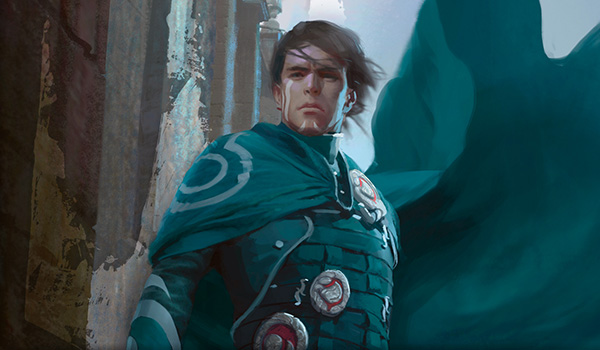Are you a Quiet Speculation member?
If not, now is a perfect time to join up! Our powerful tools, breaking-news analysis, and exclusive Discord channel will make sure you stay up to date and ahead of the curve.
Make no mistake: Grixis Death’s Shadow is by far the best deck in Modern. Last week, I was able to attend SCG Charlotte, and I saw firsthand the levels of devastation and permeation Grixis Death’s Shadow has brought upon the format. While the last match on camera was the Eldrazi Tron/Living End final, don’t think for one second that the answer to Grixis has been found. I’ve returned from the front lines to give my scouting report. Ignore it at your own peril. This is my SCG Charlotte tournament report.
Preparation
“This deck is busted.” – Cedric Phillips, on Grixis Death’s Shadow
It seems like forever ago that I was busy grinding matches and drawing up format diagrams in preparation for SCG Baltimore. While it’s only been a few weeks, so much has changed in that time, both in Magic and in real life. I went from being locked to attend both Baltimore and Charlotte, to most definitely not going, back to attending Charlotte, all in the span of a couple of days. Long story short, I found out I could play in the event on Friday morning, and the next 24 hours became a rushed attempt not only to brainstorm what I was going to play, but somehow to bring the cards together to do it.
Unsurprisingly, I settled on Grixis Death’s Shadow. I already had a list in mind that I would have taken to Baltimore, and a lot happened that weekend to confirm in my mind the preconceptions I had about the format. I knew that a lot had changed in a week as well, though, and I couldn’t sleeve up my now-outdated list and hope to make a significant impact on Saturday. How quickly things change.
The biggest change, of course, was that Grixis Death’s Shadow was now on everyone’s radar. The “window” was still open, as it had taken over the format just a few days before, but the opportunity to surprise the field was over, in a huge way. Sleeving up Grixis Death’s Shadow came with a clear understanding that I was putting the biggest target on my head by doing so. To pilot the deck was in itself a testament to its power to handle the hate.
This is the list I settled on for Saturday:
Grixis Death’s Shadow, by Trevor Holmes (SCG Charlotte)
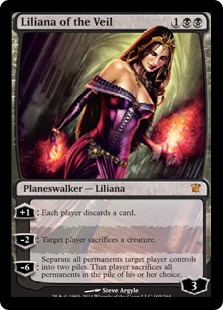 My main change from the “stock version” was the adoption of Liliana of the Veil in the maindeck and Jace, Architect of Thought in the sideboard to complement the already present Liliana, the Last Hope. The mirror is skill-intensive, to be sure, but it is also extremely luck-based, and it can be difficult to come back from lopsided draws. While I was comfortable with my experience level with the deck (I’ve been piloting Death's Shadow for months by the way, way before it was cool), I hadn’t had enough time to test the mirror beforehand. I knew going in to the event that any serious competitor sleeving up Grixis Death’s Shadow would be worried primarily about Eldrazi Tron and the mirror, and I wanted an edge against the best deck in the field, just like everyone else.
My main change from the “stock version” was the adoption of Liliana of the Veil in the maindeck and Jace, Architect of Thought in the sideboard to complement the already present Liliana, the Last Hope. The mirror is skill-intensive, to be sure, but it is also extremely luck-based, and it can be difficult to come back from lopsided draws. While I was comfortable with my experience level with the deck (I’ve been piloting Death's Shadow for months by the way, way before it was cool), I hadn’t had enough time to test the mirror beforehand. I knew going in to the event that any serious competitor sleeving up Grixis Death’s Shadow would be worried primarily about Eldrazi Tron and the mirror, and I wanted an edge against the best deck in the field, just like everyone else.
See, I knew firsthand from playing the deck that it does incredibly scary things, but has a few glaring weaknesses as well. Death's Shadow is an incredible creature, but for all its strengths, it doesn’t attack well through tokens, and it lacks haste. The deck has access to Snapcaster Mage to make things interesting, but for the most part it plans on dropping one large, cheap creature and getting to work. What does well against one large creature? Liliana of the Veil. The fact that Grixis Death’s Shadow players trimmed Lightning Bolt across the board (a move I heavily considered, but eventually didn’t make) only helps Liliana’s chances of sticking. Her only weakness (once she hits the battlefield) is Kolaghan's Command, assuming I drop her and immediately Diabolic Edict. It helps that Kolaghan's Command is usually the best card to choose with Inquisition of Kozilek/Thoughtseize anyway, so my sideboard strategy doesn’t push me off of my main plan.
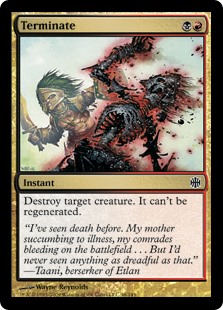 To make room for Liliana of the Veil, I trimmed a Terminate, but I should definitely have cut a Lightning Bolt instead. Not that it excuses my mistake, but I did agonize over both options for a while before submitting my list. My thinking was that Liliana of the Veil accomplishes similar objectives to Terminate in the sense that I would hopefully be using it to kill larger creatures that Fatal Push and Lightning Bolt couldn’t, and by doing so, I could retain Lightning Bolt to help against the faster matchups. In addition, I was planning on keeping the second copy of Terminate in the sideboard and knew I could side it in when necessary. In reality, I ended up using it in almost every matchup, as I wanted it against Tron for sure and played the mirror multiple times during the day. Lightning Bolt came out often, and while I didn’t drop a match in the mirror, having the extra Terminate definitely would have made things easier.
To make room for Liliana of the Veil, I trimmed a Terminate, but I should definitely have cut a Lightning Bolt instead. Not that it excuses my mistake, but I did agonize over both options for a while before submitting my list. My thinking was that Liliana of the Veil accomplishes similar objectives to Terminate in the sense that I would hopefully be using it to kill larger creatures that Fatal Push and Lightning Bolt couldn’t, and by doing so, I could retain Lightning Bolt to help against the faster matchups. In addition, I was planning on keeping the second copy of Terminate in the sideboard and knew I could side it in when necessary. In reality, I ended up using it in almost every matchup, as I wanted it against Tron for sure and played the mirror multiple times during the day. Lightning Bolt came out often, and while I didn’t drop a match in the mirror, having the extra Terminate definitely would have made things easier.
As for the sideboard, I was expecting a lot of Tron and Dredge, with the possibility of Living End or Tokens making an appearance. Jund/Abzan remained noticeably absent from the field thanks to Eldrazi Tron, but if they were ever to make an appearance, this weekend was their time. Scavenging Ooze and Lingering Souls are both great right now, as evidenced by Grixis’ renewed use of Izzet Staticaster in the sideboard. Thus, I was cautiously optimistic that I could cut Izzet Staticaster for another option that could help in the matchups that I knew I would face, and as long as I didn’t open myself up too much to Tokens, I would be able to get by.
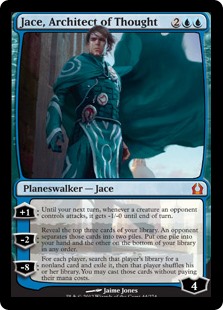 Jace, Architect of Thought fit my needs perfectly. I knew I wanted a third planeswalker for the mirror and against control, as well as a second planeswalker against Eldrazi Tron to power through the mid-game. Jace fit the bill, and even covered my bases against Lingering Souls by assuring I wouldn’t die to a swarm of fliers. Obviously it’s not as great against tokens as killing them outright, as Izzet Staticaster would, but by still being serviceable against them while providing a ton of value in other matchups I felt confident in the choice.
Jace, Architect of Thought fit my needs perfectly. I knew I wanted a third planeswalker for the mirror and against control, as well as a second planeswalker against Eldrazi Tron to power through the mid-game. Jace fit the bill, and even covered my bases against Lingering Souls by assuring I wouldn’t die to a swarm of fliers. Obviously it’s not as great against tokens as killing them outright, as Izzet Staticaster would, but by still being serviceable against them while providing a ton of value in other matchups I felt confident in the choice.
About ten minutes before decklist submission I talked myself into a third Kolaghan's Command in the board over the second Nihil Spellbomb. This was very, very wrong, and probably this decision alone cost me Day 2 at least (I finished 5-3). In my opinion, this decision was a classic case of talking myself into a narrative and “going too far down the rabbit hole," as it were. The narrative I had crafted for myself was that graveyard hate would be prevalent (which it was) and that I should be prepared to have an edge in the mirror (which I should). Basically, I convinced myself that Dredge would be a poor choice on the weekend, as it would catch secondhand graveyard hate from opponents looking to target Grixis Death’s Shadow. This also was true, but I neglected to think about whether I could beat Dredge with the sideboard spells that I had should I wind up facing it (which I did).
In the end, Kolaghan's Command and Nihil Spellbomb are both serviceable in the mirror, and outside of Affinity (which was nowhere thanks to Ceremonious Rejection) and some extra value against Eldrazi Tron, there is little benefit to Kolaghan's Command over Nihil Spellbomb against the field. Basically, I traded an important card that was great against one of my worst matchups for an okay card that wasn’t necessary against anything, and I was punished accordingly.
Tournament Report
Round 1 began with a matchup against Elves and a prompt 0-2 beating. It’s comical in a sense how true the cliché “make it out of the early rounds” rings true. When Counters Company is strictly the better deck, when removal is so prevalent that small creature decks are kept from serious consideration, when one of the best decks in the field is one of your worst matchups, still, someone chooses to show up with Elves. I don’t mean to dismiss anybody’s deck choice, and there are numerous cases where playing the exact deck everyone expects to be horrible is the right move. Still, it’s frustrating to lose to a deck that I “should” beat to start the day, when that deck wasn’t on my radar and I drew poorly.
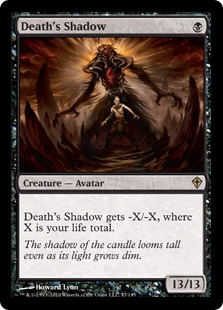 Rounds 2 and 3 went much better, and I climbed to 2-1 after beating the mirror twice. I don’t have much to say about these games other than that a combination of archetype experience, a strong plan, and a little bit of luck contributed to solid wins. Liliana of the Veil in the mainboard performed as expected, giving me a solid alternate angle of attack. Meanwhile, boarding into planeswalkers and removal while boarding out Street Wraith and Lightning Bolt made my Death's Shadow worse than theirs, but gave me plenty of alternative angles of attack while they were busy trying to deny me my graveyard.
Rounds 2 and 3 went much better, and I climbed to 2-1 after beating the mirror twice. I don’t have much to say about these games other than that a combination of archetype experience, a strong plan, and a little bit of luck contributed to solid wins. Liliana of the Veil in the mainboard performed as expected, giving me a solid alternate angle of attack. Meanwhile, boarding into planeswalkers and removal while boarding out Street Wraith and Lightning Bolt made my Death's Shadow worse than theirs, but gave me plenty of alternative angles of attack while they were busy trying to deny me my graveyard.
Round 4 saw me defeat Eldrazi Tron with a solid combination of discard, aggression, and Kolaghan's Command on Chalice of the Void. I’m not at the point where I feel comfortable boarding out a delve creature, but I won't argue with anyone who chooses to go that route. While I didn’t see any of these changes in my Tron opponent’s list, I will say in this section that Todd Steven’s adoption of Cavern of Souls and Wurmcoil Engine are both solid options for fighting Grixis Death’s Shadow. I was worried about running into Cavern of Souls throughout the day, as they don’t have to play four thanks to Expedition Map. In any case, my opponent failed to play it and I failed to draw Ceremonious Rejection in our match, so it ended up not mattering. As a final note, Street Wraith is, in my opinion, the best card in this matchup, as it gets our Death's Shadow down quickly and grows it larger than Reality Smasher/Thought-Knot Seer while digging us into sideboard spells as fast as possible.
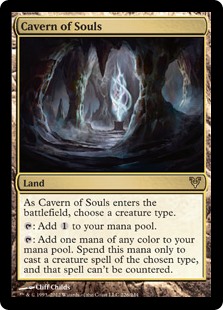 Rounds 5 and 6 yielded a win against an interesting Jeskai Burn list. While I’m sure that Serum Visions/Snapcaster Mage/Mantis Rider provide something of value to the archetype, I found the matchup easy, as I could aggressively approach Death's Shadow levels without having to worry about dying quickly to three burn spells over a one-turn sequence (one end of my turn, two on his). My opponent traded efficiency for longevity, when really what I think he needs to do in the matchup is race.
Rounds 5 and 6 yielded a win against an interesting Jeskai Burn list. While I’m sure that Serum Visions/Snapcaster Mage/Mantis Rider provide something of value to the archetype, I found the matchup easy, as I could aggressively approach Death's Shadow levels without having to worry about dying quickly to three burn spells over a one-turn sequence (one end of my turn, two on his). My opponent traded efficiency for longevity, when really what I think he needs to do in the matchup is race.
In Round 6, against classic Death’s Shadow Jund, my planeswalkers again pulled their weight; when the dust settled after trading threats and answers, the extra value was able to grind my opponent down.
Round 7 broke my five-win streak, as I ran into a Charlotte local, Joel Sukhram, piloting Jeskai Control. This match was weird, as I felt I had prepared adequately for grindy matchups, yet still found myself coming up short. If I remember correctly, Restoration Angel and Celestial Colonnade were able to deal with my Liliana of the Veil in game one, as I saw no Fatal Push. In game three, I lost to Elspeth as I drew two early Fatal Pushes and few threats. I had him on Kiki Jiki, Mirror-Breaker, which was part of the reason why I kept Push after board, and while I was correct, I never saw the combo.
I definitely feel like the Restoration Angel build of UWx Control is best against me, as it has enough removal to deal with my initial attack unless I find both an early discard spell and Stubborn Denial (which did not happen here). Fliers are a great response to my planeswalker angle of attack, and keeping in Fatal Push in a control matchup reminds me too much of my time spent playing old Grixis Control, when opponents were forced to keep in Path to Exile against me.
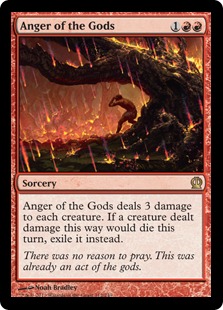 Round 8 marked the end of the road for me when I fell to Ben Friedman playing Dredge. I thought Anger of the Gods, Nihil Spellbomb, and two copies of Surgical Extraction would be enough here, but Ben played around Anger perfectly and Leyline of the Void shut down the one copy of Surgical Extraction I could find. I died in unspectacular fashion to Scourge Devil and Conflagrate in games two and three respectively. 4 Leyline of the Void is a beating. If that trend continues, Grixis Death’s Shadow might have to drop Surgical Extraction for Grafdigger's Cage, as one Nihil Spellbomb is often not enough.
Round 8 marked the end of the road for me when I fell to Ben Friedman playing Dredge. I thought Anger of the Gods, Nihil Spellbomb, and two copies of Surgical Extraction would be enough here, but Ben played around Anger perfectly and Leyline of the Void shut down the one copy of Surgical Extraction I could find. I died in unspectacular fashion to Scourge Devil and Conflagrate in games two and three respectively. 4 Leyline of the Void is a beating. If that trend continues, Grixis Death’s Shadow might have to drop Surgical Extraction for Grafdigger's Cage, as one Nihil Spellbomb is often not enough.
I dropped with one round left, hitting the road early to attend a family event. 5-3 is an underwhelming record, but I found my losses encouraging in a certain sense. Two were to decks that I did not expect to see (Elves and Jeskai Control), both of which I feel confident I could beat given another chance. The third loss was to Dredge, which I deserved after skimping on sideboard hate. The fact that only one Dredge deck cracked the Top 30 reassures me that it wasn’t the best choice for the weekend, so all in all I feel like my analysis of the weekend was correct, even though my results don’t show it.
In conclusion, I feel like I made correct choices on the weekend for the most part, and can’t point to any play mistakes that cost me the matches I lost. My area of improvement is most definitely in deck composition, as my maindeck was off by a card and my sideboard was off by at least two. Still, I can’t help but wonder what could have been had I not drawn poorly against Elves, and was able to put up more of a fight against Jeskai. Against the decks I was worried about (Death’s Shadow, Burn, and Eldrazi Tron) I finished 5-0, but if we could pick our opponents, we would all go undefeated.
Thanks for reading,
Trevor Holmes


